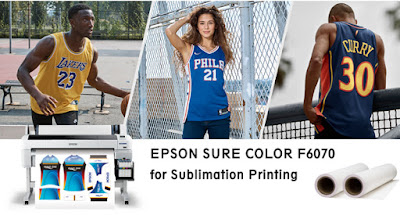What Is Sublimation?(2)
What Is Sublimation?(2)
As we are describing dye sublimation, the "solid" part of the equation denotes the microscopic particles of solid ink dyes which rest on the surface of your printed, ready-to-transfer sublimation page which you printed directly from CorelDRAW, Adobe PhotoShop or a rip program like Wasatch to a supported Epson, Ricoh, Mutoh or Mimaki sublimation printer. When introduced to heat, these solid ink particles turn directly to a gas which then permanently dye the decorated surface and sub-surface of your product, depending on whether it’s a textile or hard substrate.
The Sublimation Decoration Process
The first steps of sublimation decoration often involve the same tools used with other technologies like engraving, screen printing and embroidery. It is only after the final image is printed to paper when sublimation sets itself apart from all other technologies.
Here's the step-by-step process required to produce a sublimated product:
Design and customize a graphic specific to the final product using professional graphics software. Sublimation products showcase millions of colors utilizing high resolution, true photo quality images and any vector-based graphics and text.
Print the image to a supported inkjet printer using specialty sublimation inks on sublimation paper.
Face the printed image on the sheet to a sublimation-ready surface (e.g. polyester-based only). Some hard products like plaques and name badges will need to be taped using heat resistant tape. For soft substrates like t-shirts or mouse pads, the transfer can be "tacked" to the product using a light, repositionable adhesive spray available at any hardware, craft or super store, or by using a tacky sublimation paper, currently only available for wide format printers.
Place the product and sublimation print under a heat press. Each product type has its own formula for time, temperature and pressure for optimal decorating. The proper temperature usually hovers between 385° F to 400° F, time varies from 50 seconds for a Vapor Apparel t-shirt to over seven minutes for a glossy, ceramic tile. The required pressure is usually "medium" or around 30-40 psi on a pneumatic press. You're looking for a solid marriage between the heated platen and the face of your sublimation transfer (where the solid ink dyes rest).
After the time expires, remove the product (using protective heat gloves is recommended when handling many sublimation products), tear away the transfer and admire the finished image. Besides assembly for some products (e.g. gift boxes, tile murals, etc.), the product is ready for delivery after cooling.
★About us★
We are sublimation paper professional supplier.Our company can supply any need about Epson printer, Epson ink, sublimation
transfer paper,sublimation ink, heat transfer paper for textile printing! www.feiyuepaper.com
★More info★
Website: www.feiyuepaper.com
Whatsapp/Wechat:008613776614520
Email:sales@feiyuepaper.com
Skype: li.sunny282
If you have any questions,call me,let's talk details.
★Follow Us★
Facebook: https://www.facebook.com/onestopsublimationsolutions/
Linkedin: https://www.linkedin.com/company/sublimation-skyimage/
Twitter: https://twitter.com/printerspare?lang=zh-cn
Pinterest: https://www.pinterest.com/sublistarprinterspare/
Google+: https://plus.google.com/+InkSublimationSunny/posts
Youtube: https://www.youtube.com/channel/UCvfhRcVPCNVm0YTdCCORPbw
Vk: https://vk.com/id324602723
Blogspot: https://sublimatestar.blogspot.com/
As we are describing dye sublimation, the "solid" part of the equation denotes the microscopic particles of solid ink dyes which rest on the surface of your printed, ready-to-transfer sublimation page which you printed directly from CorelDRAW, Adobe PhotoShop or a rip program like Wasatch to a supported Epson, Ricoh, Mutoh or Mimaki sublimation printer. When introduced to heat, these solid ink particles turn directly to a gas which then permanently dye the decorated surface and sub-surface of your product, depending on whether it’s a textile or hard substrate.
The Sublimation Decoration Process
The first steps of sublimation decoration often involve the same tools used with other technologies like engraving, screen printing and embroidery. It is only after the final image is printed to paper when sublimation sets itself apart from all other technologies.
Here's the step-by-step process required to produce a sublimated product:
Design and customize a graphic specific to the final product using professional graphics software. Sublimation products showcase millions of colors utilizing high resolution, true photo quality images and any vector-based graphics and text.
Print the image to a supported inkjet printer using specialty sublimation inks on sublimation paper.
Face the printed image on the sheet to a sublimation-ready surface (e.g. polyester-based only). Some hard products like plaques and name badges will need to be taped using heat resistant tape. For soft substrates like t-shirts or mouse pads, the transfer can be "tacked" to the product using a light, repositionable adhesive spray available at any hardware, craft or super store, or by using a tacky sublimation paper, currently only available for wide format printers.
Place the product and sublimation print under a heat press. Each product type has its own formula for time, temperature and pressure for optimal decorating. The proper temperature usually hovers between 385° F to 400° F, time varies from 50 seconds for a Vapor Apparel t-shirt to over seven minutes for a glossy, ceramic tile. The required pressure is usually "medium" or around 30-40 psi on a pneumatic press. You're looking for a solid marriage between the heated platen and the face of your sublimation transfer (where the solid ink dyes rest).
After the time expires, remove the product (using protective heat gloves is recommended when handling many sublimation products), tear away the transfer and admire the finished image. Besides assembly for some products (e.g. gift boxes, tile murals, etc.), the product is ready for delivery after cooling.
★About us★
We are sublimation paper professional supplier.Our company can supply any need about Epson printer, Epson ink, sublimation
transfer paper,sublimation ink, heat transfer paper for textile printing! www.feiyuepaper.com
★More info★
Website: www.feiyuepaper.com
Whatsapp/Wechat:008613776614520
Email:sales@feiyuepaper.com
Skype: li.sunny282
If you have any questions,call me,let's talk details.
★Follow Us★
Facebook: https://www.facebook.com/onestopsublimationsolutions/
Linkedin: https://www.linkedin.com/company/sublimation-skyimage/
Twitter: https://twitter.com/printerspare?lang=zh-cn
Pinterest: https://www.pinterest.com/sublistarprinterspare/
Google+: https://plus.google.com/+InkSublimationSunny/posts
Youtube: https://www.youtube.com/channel/UCvfhRcVPCNVm0YTdCCORPbw
Vk: https://vk.com/id324602723
Blogspot: https://sublimatestar.blogspot.com/






评论
发表评论